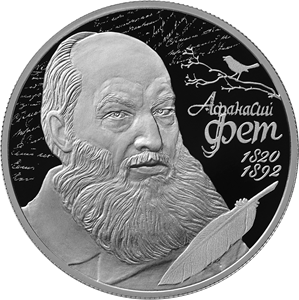Poet A.A. Fet – 200th Anniversary of his Birth (05.12.1820)
Obverse
the mirror field of the disc bears a relief image of the National Coat of Arms of the Russian Federation, over it along the rim there is the semicircular inscription ‘РОССИЙСКАЯ ФЕДЕРАЦИЯ’ (RUSSIAN FEDERATION) framed on both sides by doubled rhombuses, below under the coat of arms there are indications of the precious metal and its fineness on the left and the fine metal content and the mint trade mark on the right, at the bottom in the centre, in three lines, there is an inscription ‘БАНК РОССИИ’ (BANK OF RUSSIA), the denomination of the coin ‘2 РУБЛЯ’ (2 RUBLES), and the year of issue ‘2020 г.’ (2020).
Reverse
the mirror field of the disc bears a relief portrait of Afanasy Fet against the background of stylised lines of poetry; the right side bears relief images of a feather and a singing nightingale, a two-line inscription ‘АФАНАСИЙ ФЕТ’ (AFANASY FET) and the poet's life years ‘1820’ and ‘1892’.
Authors
Designers: E.V. Kramskaya (obverse), A.V. Baklanov, National Artist of Russia (reverse).
Sculptors: A.A. Dolgopolova (obverse), A.N. Bessonov (reverse).
Mint: Saint Petersburg Mint (СПМД).
Edge: 195 corrugations.
Discover more
Afanasy Afanasyevich Fet (1820–1892) was a Russian poet, translator, memoirist, and a corresponding member of the St. Petersburg Academy of Sciences (1886).
Fet studied at home, however, he absorbed most of his knowledge from nature, peasant and rural life. Later he enrolled in the Faculty of History and Philology at the Moscow University, where he began to write poetry. Professor Mikhail Pogodin showed his poems to Nikolai Gogol and soon received an opinion from the famous writer: 'undoubtedly gifted'.
In 1840, the first Fet's poetry collection called 'Lyric Pantheon' was published. It included ballads, elegies, idylls and epitaphs. The collection was praised by critics Vissarion Belinsky, Pyotr Kudryavtsev, and poet Yevgeny Baratynsky. A year later, Fet's poems were regularly appearing in the Moskvityanin – a literary review by Pogodin – and in the Otechestvennye Zapiski magazine.
In 1850, Fet published his second poetry collection, which was praised by major Russian magazines. Soon, the Sovremennik magazine started to publish Fet's poems. In 1856, the book 'Poems by A.A. Fet' saw the light. Encouraged by his success, Fet began writing long poems, poetry novels, prose, as well as travel essays and critical reviews. Also, he translated works by Heinrich Heine, Johann Goethe, André Chénier, Adam Mickiewicz and other poets. In 1863, Fet published another book – a two-volume collection of his poetry. Some critics enjoyed the book, noting the author's 'great lyrical talent', others replied with harsh articles and parodies. In 1883, after a twenty-year break, a new poetry book called 'Evening Lights' was published. By this time, Fet had accepted the fact that his works were 'not for everyone'.
In the final years of his life, the poet received public recognition. In 1884, he became the first winner of the full Pushkin Prize of the Imperial Academy of Sciences for translations of Horace's works. Two years later, Fet was elected its corresponding member. In 1888, Afanasy Fet was personally introduced to Emperor Alexander III and was awarded the court title of chamberlain.
Source: https://www.culture.ru


